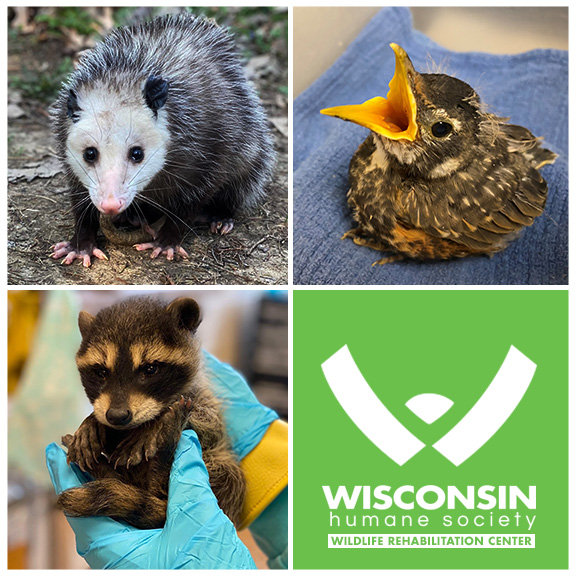Trapping and Relocating Wildlife
CLICK HERE for a print-friendly PDF and photos!
Situation: Though sometimes touted as a quick solution to conflicts with “nuisance” animals, trapping and relocating wildlife seldom provides a lasting solution to such problems. Furthermore, it often causes baby animals to become orphaned and thus die, and studies indicate that relocated animals may not survive long after relocation.
FAQs & Humane Solutions:
“I have a wild animal causing a problem in my yard. Will you come out here and remove it, or can I rent a live-trap from you so I can trap it myself?”
The answer to both questions is “No,” because we have much better solutions to offer: Experience with thousands of such situations over many decades has shown us that the self-help techniques we describe in the links below are much more humane than trapping and relocating an animal, provide a more ecologically-sound solution than relocation, and are more likely to provide you with a lasting solution at less expense than removal/relocation.
“Why doesn’t trapping and relocating an animal provide a long-term solution?”
There is a saying: “Nature abhors a vacuum.” This is certainly true when it comes to wildlife relocation. If you trap and remove one animal, another will likely move into the “vacuum” you created when you removed the first animal from its territory. This fact was illustrated perfectly in a newspaper story a few years ago. The story profiled a man from our area who live-trapped and relocated nearly every wild animal that happened into his yard. After ten years of trapping and removal, this person had moved hundreds of gray squirrels and dozens of other animals such as raccoons, woodchucks and opossums. Of course, this man did not have 300 squirrels living in his yard at one time, but moving one animal out made room for others. These are often young animals moving out of their parent’s territory to find their own.
We have seen this sort of thing happen countless times, but to give you just one other example: someone had an animal removal service trap and remove Gray Squirrels that were getting into their attic. These folks paid hundreds of dollars to have the removal company trap and remove seven gray squirrels from their yard. This seemed to solve the problem temporarily, but within six months they had squirrels getting into their attic again because the real cause of the problem, an unscreened attic vent that let the squirrels get access to the attic, was not addressed.
“Why would trapping and removing animals cause babies to become orphaned?”
The usual scenario is that someone traps and removes a wild animal from their property for one reason or another, and then the next day or even days later, hears the weak, hungry cries of the babies that were left behind in the mother’s hidden den. These babies will not survive without their mother’s care. Using the humane nuisance-resolution techniques we illustrate in the links at the end of this article rarely causes a mother to abandon her babies and gives her time to safely relocate her young.
“Why would trapped animals have a hard time thriving after they are relocated?”
A relocated animal does not know where food, water and shelter are located, and is not aware of dangers such as predators in this new area. It also has to compete with others of its kind to establish a new territory of its own. Animals such as squirrels that cache food for the winter will almost certainly die if they are trapped and relocated during the winter.
A key factor in the post-release survival of relocated animals is the quality of the habitat at the release site. One review of several relocation studies concluded that relocations to “poor-quality habitats” can result in survival rates averaging only 38%. “Translocations made by well-meaning, but poorly-informed and untrained private citizens, are unlikely to give adequate consideration to habitat and other factors.” (Translocation as a species conservation tool: status and strategy. B. Griffith, J.M. Scott, J.W. Carpenter, and C. Reed. 1989. Science 245: 477-480).
In one study of urban and suburban Gray Squirrels that were trapped and relocated to a forest, 97% of the squirrels were dead or had disappeared from the release area within 88 days. (Movement and mortality of translocated urban-suburban grey squirrels. L.W. Adams, J. Hadidian, and V. Flyger, in Animal Welfare 2004, 13: 45-50).
In one study of relocated raccoons, the authors determined that there was a 50% mortality rate at three months post-release. They further concluded that mortality may have been as high as 75% after one year. (Relocation of city raccoons. R.C. Rosatte and C.D. MacInnes. 1989. Proceedings of the Great Plains Wildlife Damage Conference 9: 87-92).
“So what else can I do besides trapping and removal to solve my wildlife problem?”
We have a wealth of resources on our web site. Our resources focus on identifying root problems (what, specifically, is the problem, and why is the animal doing what it is doing?) and offer humane, cost-effective, sustainable, and biologically-sound methods for resolving conflicts with urban-suburban wildlife.

.png)

